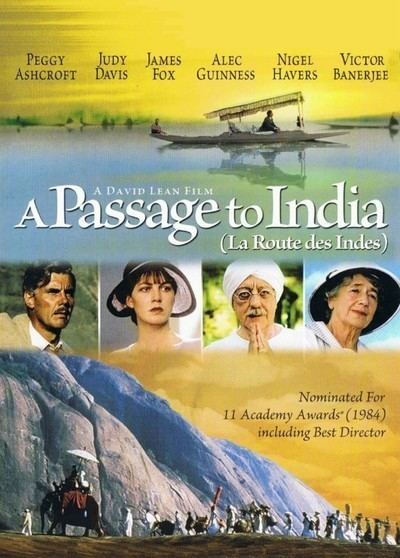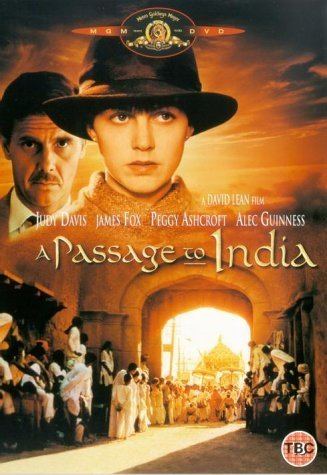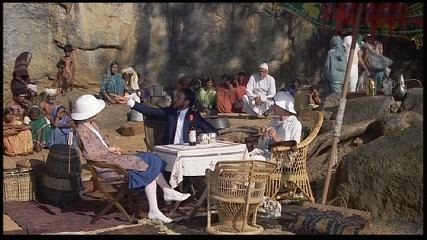A Passage to India (film)
8.6 /10 1 Votes
4/4 Roger Ebert Adapted from A Passage to India Country United KingdomUnited States | 7.4/10 IMDb 85% Rotten Tomatoes Genre Adventure, Drama, History Duration Language English | |||||||||||||||||||||||||||||||||
 | ||||||||||||||||||||||||||||||||||
Release date 14 December 1984 (1984-12-14) Based on A Passage to India1924 novel by E. M. Forster Writer E.M. Forster (by), E.M. Forster (based on the novel by), Santha Rama Rau (and the play by), David Lean (screenplay) Cast (Adela Quested), (Prof. Godbole), (Mrs. Moore), (Richard Fielding), (Dr. Aziz H. Ahmed), (Ronny Heaslop) Similar movies Related David Lean movies | ||||||||||||||||||||||||||||||||||
A passage to india trailer
A Passage to India is a 1984 British period drama film written and directed by David Lean. The screenplay is based on the play of the same name by Santha Rama Rau, which was based on the novel of the same name by E.M. Forster.
Contents

This was the final film of Lean's career, and the first feature-film he had directed in fourteen years, since Ryan's Daughter in 1970. Receiving universal critical acclaim upon its release with many praising it as Lean's finest since Lawrence of Arabia, A Passage to India received eleven nominations at the Academy Awards, including Best Picture, Best Director for Lean, and Best Actress for Judy Davis for her portrayal as Adela Quested. Peggy Ashcroft won the Academy Award for Best Supporting Actress for her portrayal as Mrs Moore, making her, at 77, the oldest actress to win the award, and Maurice Jarre won his third Academy Award for Best Original Score.

Plot

Adela Quested (Judy Davis) is sailing from England to British Raj India with Mrs Moore (Peggy Ashcroft), the latter the mother of her intended bridegroom, Ronny Heaslop (Nigel Havers); Mrs Moore's son from her first marriage. He is a magistrate in Chandrapore. Adela intends to see if she can make a go of it.

The ladies are disappointed to find that the British community is very much separated from the Indian population and culture with a growing Indian independence movement in the 1920s. They are encouraged when the local school superintendent Richard Fielding (James Fox), brings into their acquaintance the eccentric elderly Hindu Brahmin scholar Professor Narayan Godbole (Alec Guinness). Mrs Moore meets by chance another Indian local, Dr Aziz Ahmed (Victor Banerjee), a widower who is surprised by her kindness and lack of prejudice. Aziz offers to host an excursion to the local Marabar Caves.

The initial exploration of the caves shows that those included in the party should be limited when Mrs Moore suffers from claustrophobia and the noise from the large entourage echoes exponentially inside the caves. Mrs Moore encourages Adela and Aziz to continue their exploration of the caves alone with just one guide.

They reach the caves at a higher elevation some distance from the group and, before entering, Aziz steps away to take a cigarette. He returns to find Adela has disappeared. Shortly after he sees her running headlong down the hill, disheveled. She is picked up by the doctor's wife, Mrs. Callendar (Ann Firbank), and taken to the Callendars' home. Adela is bleeding and delirious. Dr Callendar medicates Adela with a hypodermic syringe.

Upon his return to Chandrapore, Aziz is jailed to await trial, and the incident becomes a cause célèbre. Mrs Moore firmly believes Aziz to not have committed any offense and she leaves India for England. At sea, Mrs Moore takes ill and dies quickly.

In court, Adela is questioned by the prosecution; it becomes clear to her that her earlier signed accusation of attempted rape was incorrect and she recants. Aziz is celebrated for his innocence and Adela is abandoned to her own devices by the British except for Mr Fielding who assists her to safety to the college. She plans to return to England at the earliest moment. Aziz rids himself of his western associations and vows to find a new job in an Indian state; he opens a clinic in the lake area near Srinagar, Kashmir.
Meanwhile, through Adela, Fielding has married Stella Moore, Mrs Moore's daughter from her second marriage. Aziz eventually reconciles with Fielding, and Aziz writes to Adela asking her to forgive him for taking so long to come to appreciate the courage she exercised when she withdrew her accusation in court.
Background
E. M. Forster began writing A Passage to India during a stay in India from late 1912 to early 1913 (he was drawn there by a young Indian Muslim, Syed Ross Masood, whom he had tutored in Latin), completing it only after he returned to India as secretary to a maharajah in 1921. The novel was published on 6 June 1924. It differs from Forster's other major works in the overt political content, as opposed to the lighter tone and more subdued political subtext in works such as Howards End and A Room With a View.
A Passage to India deals with the delicate balance between the English and the Indians during the British Raj. The question of what actually happened in the caves remains unanswered in the novel. A Passage to India sold well and was widely praised in literary circles. It is generally regarded as Forster's best novel, quickly becoming a classic of English literature.
Over many years several film directors were interested in adapting the novel to the big screen, but Forster, who was criticized when the novel was published, rejected every offer for the film rights believing that any film of his novel would be a travesty. He feared that whoever made it would come down on the side of the English or the Indians, and he wanted balance. However he did allow Indian author Santha Rama Rau to adapt the novel for the theatre in 1957.
David Lean had read the novel and saw the play in London in 1960, and, impressed, attempted to purchase the rights at that time, but Forster, who rejected Santha Rama Rau's suggestion to allow Indian film director Satyajit Ray to make a film, said no. Following Forster's death in 1970, the governing board of fellows of King's College at Cambridge inherited the rights to his books. However, Donald A Parry, chief executor, turned down all approaches, including those of Joseph Losey, Ismail Merchant and James Ivory, and Waris Hussein, who after adapting Santha Rama Rau's play now wanted to make a feature film. Ten years later, when Professor Bernard Williams, a film enthusiast, became chief executor, the rights for a film adaptation became available.
Lord Brabourne, (John Knatchbull, 7th Baron Brabourne), whose father had been Governor of Bombay and later Governor of Bengal, and who was married to the daughter of Lord Mountbatten, the last viceroy, had sought the film rights for twenty years. He had produced Franco Zeffirelli's Romeo and Juliet and films based on Agatha Christie’s mysteries including the 1974 Murder on the Orient Express. In March 1981, John Brabourne and his business partner, Richard Goodwin, obtained the rights to make a film adaptation of A Passage to India. The contract stipulated that Santha Rama Rau write the screenplay and it reserved the right to approve the director.
Brabourne, an admirer of the film Doctor Zhivago, wanted David Lean to direct the film. Lean was ready to break his 14-year hiatus from filmmaking following mostly negative reviews received for Ryan's Daughter in 1970. Since then, Lean had fought to make a two-part epic telling the true story of the mutiny on the Bounty, for which he could not obtain financing, and had given some thought about doing a film adaptation of Out of Africa, from the book by Isak Dinesen, which Sydney Pollack ultimately directed in 1985. By September 1981, Lean was approved as director and Santha Rama Rau completed a draft of the script.
Writing
The contract stipulated that Santha Rama Rau would write the screenplay. She had met with E. M. Forster; had successfully adapted A Passage to India as a play; and the author had charged her with preserving the spirit of the novel. However, Lean was determined to exercise input in the writing process. He met with Santha Rama Rau in Berkeley, Gloucestershire, and over ten days they talked about the novel and discussed the script.
The initial script by Santha Rama Rau pleased neither the producer, John Brabourne, nor David Lean. They considered it too worldly and literary, the work of a playwright, and unsuitable for a film. Most of the scenes took place indoors and in offices while Lean had in mind to film outdoor as much as possible. With India in the title of the film, he reasoned, audiences would expect to see many scenes filmed of the Indian landscape. Lean commented: "We are blessed with a fine movie title, A Passage to India. But it has built in danger; it holds out such a promise. The very mention of India conjures up high expectations. It has sweep and size and is very romantic". Lean did not want to present a poor man's pre-independence India when for the same amount of money he could show the country's visual richness.
During 1982, Lean worked on the script. He spent six months in New Delhi, to have a close feeling of the country while writing. As he could not stay longer than that for tax reasons, then he moved to Zurich for three months finishing it there. Following the same method he had employed adapting Charles Dickens’s Great Expectations, he went through Rau's original script, and his copy of the novel, picking out the episodes that were indispensable and passing over those that did not advance the plot. Lean typed out the whole screenplay himself correcting it as he went along, following the principle that scripts are not written, but rewritten.
Casting
The director cast Australian actress Judy Davis, then 28, as the naive Miss Quested after a two-hour meeting. When Davis gave her interpretation of what happened in the caves — “She can’t cope with her own sexuality, she just freaks out” — Lean said that the part was hers. Davis had garnered international attention in Gillian Armstrong’s My Brilliant Career (1979) and had appeared in A Woman Called Golda (1982) as a young Golda Meir.
Lean wanted Celia Johnson, star of Brief Encounter, to play Mrs Moore, but she turned down the part and died before the film was released. The director then offered the part to Peggy Ashcroft, a stage actress who had appeared in films only sporadically. She was not enthusiastic when Lean asked her to be Mrs Moore. "Mr Lean, I’m 75-years-old," she protested. "So am I," he replied. Although she had recently worked in India on the T.V. miniseries The Jewel in the Crown, she said, "I thought, 'Oh dear, I really don’t want to do it', but it's very difficult to turn down a Lean film."
Satyajit Ray, who had hoped to direct his adaptation of A Passage to India, recommended 38-year-old Bengali actor Victor Banerjee for the role of Dr Aziz. The character required a combination of foolishness, bravery, honour and anger. After some hesitation, Lean cast Banerjee, but the director had to overcome the restrictions of British equity to employ an Indian actor. Lean got his way, and the casting made headlines in India. "It was a matter of national pride that an Indian was cast instead of an Asian from England," observed Banerjee.
Peter O'Toole was Lean's first choice to play Fielding. The role eventually went to James Fox. Despite having quarrelled with Lean in the 1960s about a proposed film about Gandhi that ultimately was scrapped, Alec Guinness agreed to portray Professor Godbole. The relationship between the two men deteriorated during filming, and when Guinness learned that much of his performance was left on the cutting room floor due to time constraints, he saw it as a personal affront. Guinness would not speak to Lean for years afterwards, only patching things up in the last years of Lean's life. Nigel Hawthorne was cast as Turton but fell ill and was replaced on-set by Richard Wilson.
Filming
The Marabar Caves are based on the Barabar Caves, some 35 km north of Gaya, in Bihar. Lean visited the caves during pre-production, and found them flat and unattractive; concerns about bandits were also prevalent. Instead he used the hills of Savandurga and Ramadevarabetta some tens of kilometers from Bangalore, where much of the principal film took place; small cave entrances were carved out by the production company. Other scenes were filmed in Ramanagaram (Karnataka) and Udhagamandalam (Tamil Nadu) and in Srinagar (Jammu and Kashmir), with some interiors being shot at Shepperton Studios in Surrey and in Bangalore Palace.
Filming took place from November 1983 to June 1984.
Critical reception
Lean's final film became a critics' favourite in 1984, opening to tremendous praise worldwide. Vincent Canby of The New York Times called Lean's film "his best work since The Bridge on the River Kwai and Lawrence of Arabia and perhaps his most humane and moving film since Brief Encounter. Though vast in physical scale and set against a tumultuous Indian background, it is also intimate, funny and moving in the manner of a film maker completely in control of his material . . . Though [Lean] has made A Passage to India both less mysterious and more cryptic than the book, the film remains a wonderfully provocative tale, full of vivid characters, all played to near perfection."
Roger Ebert of the Chicago Sun-Times observed that "Forster's novel is one of the literary landmarks of this century, and now David Lean has made it into one of the greatest screen adaptations I have ever seen . . . [He] is a meticulous craftsman, famous for going to any length to make every shot look just the way he thinks it should. His actors here are encouraged to give sound, thoughtful, unflashy performances . . . and his screenplay is a model of clarity."
Variety called the film "impeccably faithful, beautifully played and occasionally languorous" and added, "Lean has succeeded to a great degree in the tricky task of capturing Forster's finely edged tone of rational bemusement and irony."
Time Out London thought the film was "a curiously modest affair, abandoning the tub-thumping epic style of Lean's late years. While adhering to perhaps 80 per cent of the book's incident, Lean veers very wide of the mark over E.M. Forster's hatred of the British presence in India, and comes down much more heavily on the side of the British. But he has assembled his strongest cast in years . . . And once again Lean indulges his taste for scenery, demonstrating an ability with sheer scale which has virtually eluded British cinema throughout its history. Not for literary purists, but if you like your entertainment well tailored, then feel the quality and the width."
Channel 4 said, "Lean was always preoccupied with landscapes and obsessed with the perfect shot – but here his canvas is way smaller than in Lawrence of Arabia, for instance . . . Still, while the storytelling is rather toothless, A Passage to India is certainly well worth watching for fans of the director's epic style."
Home video
Sony Pictures Home Entertainment released the first DVD on 20 March 2001. It was in anamorphic widescreen format with audio tracks and subtitles in English, French, and Spanish. Bonus features included Reflections of David Lean, an interview with the screenwriter/director, cast biographies, and production notes.
On 9 September 2003, Columbia Pictures released the box set The David Lean Collection, which included Lawrence of Arabia, The Bridge on the River Kwai, and A Passage to India.
On 15 April 2008, Sony released A Passage To India (2-Disc Collector's Edition). In addition to Reflections of David Lean from the 2001 release, bonus features included commentary with producer Richard B. Goodwin; E.M. Forster: A Profile of an Author, covering some of the main themes of the original book; An Epic Takes Shape, in which cast and crew members discuss the evolution of the film; An Indian Affair, detailing the primary production period; Only Connect: A Vision of India, detailing the final days of shooting at Shepperton Studios and the post-production period; Casting a Classic, in which casting director Priscilla John discusses the challenges of bringing characters from the book to life; and David Lean: Shooting with the Master, a profile of the director. On 15 April 2008, Sony released a Blu-ray HD Collector's Edition. With a restored print and new digital mastering.
References
A Passage to India (film) WikipediaA Passage to India (film) IMDbA Passage to India (film) Roger EbertA Passage to India (film) Rotten TomatoesA Passage to India (film) themoviedb.org
